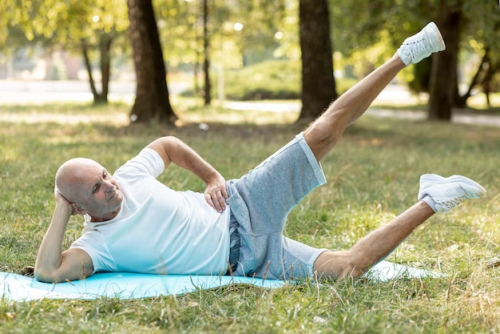Arthritis can significantly impact daily life, particularly when it affects major joints like the hips and shoulders. Both of these joints play crucial roles in movement, stability, and overall quality of life. While the pain and limitations caused by arthritis can be daunting, engaging in regular exercise specifically designed for these joints can help manage symptoms, improve function, and enhance overall joint health. In this blog, we will explore effective exercises for hip arthritis exercises, discuss the benefits of combining these exercises, and offer tips for a safe and effective workout routine.
Understanding Arthritis in the Hip and Shoulder
What is Arthritis?
Arthritis is an umbrella term that refers to inflammation of the joints. It encompasses various types, including osteoarthritis (OA) and rheumatoid arthritis (RA). Osteoarthritis is the most common form and is characterized by the wear and tear of cartilage, leading to pain, stiffness, and swelling. Rheumatoid arthritis, on the other hand, is an autoimmune disorder that affects the lining of the joints.
Symptoms of Hip and Shoulder Arthritis
The symptoms of arthritis in the hip and shoulder can include:
Pain during movement or at rest
Stiffness, particularly after periods of inactivity
Swelling and inflammation around the joint
Reduced range of motion
Weakness in the surrounding muscles
These symptoms can vary in intensity and may be exacerbated by certain activities or weather conditions.
The Importance of Exercise for Arthritis Management
Engaging in regular exercise can provide numerous benefits for individuals with arthritis, including:
Pain Relief: Gentle movement can help reduce stiffness and improve circulation, alleviating pain.
Increased Strength: Strengthening the muscles around the affected joints provides better support and stability.
Improved Flexibility: Stretching exercises enhance the range of motion and reduce stiffness in the joints.
Weight Management: Maintaining a healthy weight reduces strain on weight-bearing joints like the hips.
Enhanced Mental Well-being: Exercise can improve mood and reduce feelings of depression or anxiety related to chronic pain.
Combining Hip and Shoulder Exercises
When creating an exercise routine for hip and shoulder arthritis, it’s beneficial to include a combination of stretching, strengthening, and low-impact aerobic activities. Below are effective exercises that target both areas:
1. Gentle Stretching
Hip Flexor Stretch
How to Do It:
Start in a lunge position with one foot forward and the other knee on the ground.
Keep your back straight and gently push your hips forward.
Hold for 20-30 seconds and switch sides.
Shoulder Stretch
How to Do It:
Stand or sit tall and reach one arm across your chest.
Use the opposite hand to gently pull your arm closer to your body.
Hold for 20-30 seconds and switch sides.
2. Strengthening Exercises
Side Leg Raises (for Hip Strength)
How to Do It:
Stand tall and hold onto a chair or wall for support.
Lift one leg straight out to the side, keeping your knee straight.
Hold for a moment, then lower it back down.
Repeat 10-15 times on each side.
Wall Push-Ups (for Shoulder Strength)
How to Do It:
Stand an arm's length away from a wall, place your palms on the wall at shoulder height.
Slowly bend your elbows and lean toward the wall, then push back to the starting position.
Aim for 10-15 repetitions.
3. Low-Impact Aerobic Activities
Walking
Walking is an excellent low-impact exercise that can be done almost anywhere. Aim for 20-30 minutes of brisk walking several times a week.
Swimming
Swimming or water aerobics are fantastic options for those with arthritis. The buoyancy of water reduces joint stress while allowing for a full range of motion.
Creating a Balanced Routine
Combining hip and shoulder exercises into a balanced routine can help maximize benefits while minimizing the risk of injury. Here’s a sample weekly plan:
Weekly Exercise Plan
Day 1: Stretching and Strengthening
Hip Flexor Stretch
Side Leg Raises
Shoulder Stretch
Wall Push-Ups
Day 2: Low-Impact Aerobic Activity
20-30 minutes of brisk walking
Day 3: Stretching and Strengthening
Repeat Day 1 routine
Day 4: Rest or Gentle Yoga
Day 5: Low-Impact Aerobic Activity
20-30 minutes of swimming or water aerobics
Day 6: Stretching and Strengthening
Repeat Day 1 routine
Day 7: Rest or Light Activity
Tips for Safe Exercise
Consult a Professional: Before starting any exercise program, consult with a healthcare provider or physical therapist, especially if you have chronic pain or other health conditions.
Listen to Your Body: Pay attention to your body’s signals. If an exercise causes pain or discomfort, modify it or stop.
Warm Up and Cool Down: Always start with a gentle warm-up to prepare your muscles and end with a cool-down to promote recovery.
Use Supportive Gear: If necessary, use supportive devices like knee braces or proper footwear to reduce strain on your joints.
Stay Consistent: Aim for regularity in your exercise routine. Consistency is key to managing arthritis symptoms effectively.
The Role of Nutrition in Joint Health
While exercise plays a crucial role in managing arthritis, nutrition is equally important. A well-balanced diet rich in anti-inflammatory foods can support joint health. Consider incorporating:
Fruits and Vegetables: High in antioxidants, they help reduce inflammation.
Omega-3 Fatty Acids: Found in fish, flaxseeds, and walnuts, these can help decrease joint pain.
Whole Grains: Foods like brown rice and quinoa can provide energy without contributing to inflammation.
Lean Proteins: Chicken, turkey, and legumes support muscle repair and strength.
Conclusion
Combining hip and shoulder arthritis exercises can lead to significant improvements in joint health and overall quality of life. By incorporating stretching, strengthening, and low-impact aerobic activities into your routine, you can alleviate pain, enhance mobility, and regain independence. Always remember to consult with a healthcare professional before starting any exercise regimen, and listen to your body’s needs. With commitment and the right approach, you can effectively manage arthritis and enjoy a more active, fulfilling life. Embrace the journey toward better joint health today!












